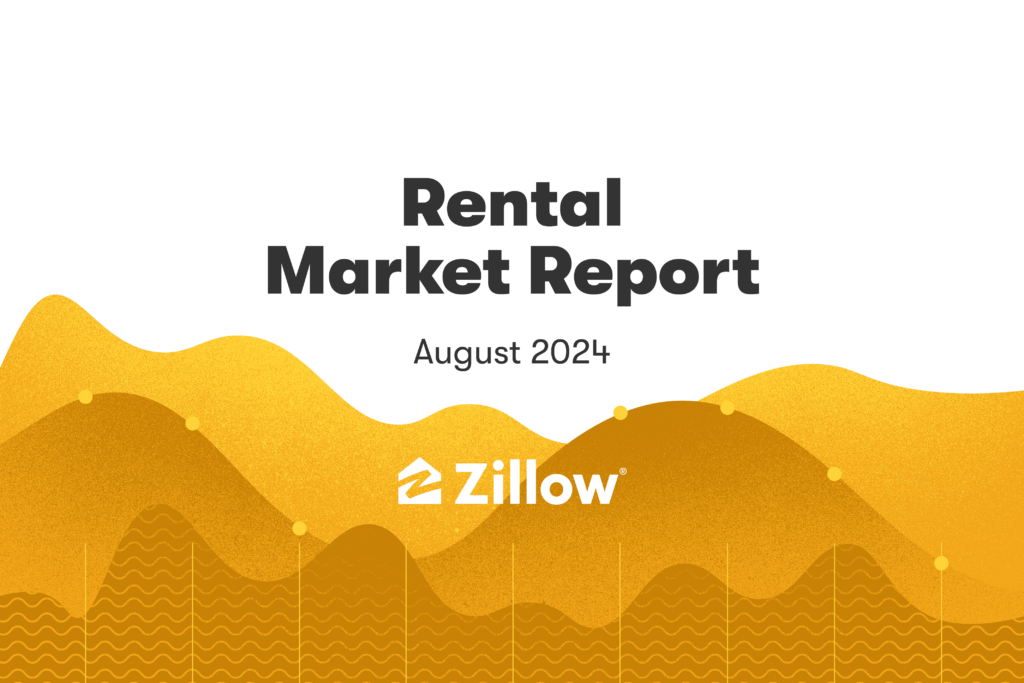Renter demand relative to the number of available rental listings softened in August, as more multi-family new construction came online. Cooling demand and rising inventory has led to slowing rent growth and rising concessions as property managers look to entice renters amid persisting affordability challenges.
Rents rose modestly by 0.2% from July to August to $2,063. This seasonal increase is consistent with the pre-pandemic average month-over-month change for this time of year, but softer than last year and much softer than 2021 and 2022. Year-over-year, rents remain up only 3.4%, unchanged from July. Rents declined in eight major metros since last month, but remain up year-over-year in every major metro except Austin.
Meanwhile, rental concessions continued to rise in most metros. In August, more than a third (34.3%) of listings on Zillow offered a concession, which is a short-term rental incentive like weeks of free rent or free parking. This is the highest share of concessions offered since March 2021.
Despite slowing rent growth and increasing shares of short-term concessions, rents across the country remain at record highs. The median household continues to spend about 30% of their income on rent, 1.4 percentage points higher than the pre-pandemic share of median household income spent on rent. The income needed to comfortably afford the typical U.S. rent — meaning spending no more than 30% of income — is now $82,514, up 31.8% since 2019.
As more multi-family new construction is completed and more rentals come on the market, rent growth will likely continue to moderate. Additionally, recent declines in mortgage rates may pull more renters into the sales market, further softening rental demand. But despite these glimmers of hope for renters, multi-family construction starts have fallen to pre-pandemic levels, which could signal that the modest improvements in rent affordability may not last for long.
Rents
- The typical U.S. asking rent is $2,063 as of August, up 0.2% from July.
- U.S. rents remain up 3.4% from last year.
- Since the beginning of the pandemic, U.S. rents have increased by 33.6%.
- Rents fell, on a monthly basis, in eight major metro areas. The largest monthly drops are in Austin (-0.9%), Boston (-0.4%), Orlando (-0.1%), Atlanta (-0.1%), and Denver (-0.1%).
- Rents are up from year-ago levels in all but one of the 50 largest metro areas. Annual rent increases are highest in Hartford (7.8%), Cleveland (7%), Louisville (6.9%), Richmond (6.7%), and Providence (6.2%).
Single-Family Rents
- The typical U.S. asking rent for single-family homes is $2,273 as of August, up 0.3% from July.
- Single-family rents are now up 4.5% from last year.
- Since the beginning of the pandemic, single-family rents have increased by 40.4%.
- Single-family rents fell, on a monthly basis, in three major metro areas: Austin (-0.6%), Orlando (-0.2%), and San Diego (-0.1%).
- Single-family rents are up from year-ago levels in all but one of the 50 largest metro areas. Annual single-family rent increases are highest in Cleveland (8.1%), Cincinnati (7.7%), Columbus (7.5%), Indianapolis (7.4%), and Hartford (7.3%).
Multi-Family Rents
- The typical U.S. asking rent for multi-family homes is $1,912 as of August, up 0.1% since July.
- Multi-family rents are now up 2.5% from last year.
- Since the beginning of the pandemic, multi-family rents have increased by 27.3%.
- Multi-family rents fell, on a monthly basis, in 14 major metro areas. The largest monthly drops in multi-family rents are in Austin (-0.9%), Boston (-0.5%), Atlanta (-0.5%), Nashville (-0.4%), and Raleigh (-0.3%).
- Multi-family rents are up from year-ago levels in 41 of the 50 largest metro areas. Annual multi-family rent increases are highest in Hartford (7.8%), Louisville (6.4%), Providence (6.2%), Cleveland (6.1%), and Richmond (5.7%).
Rent Concessions
- 34.3% of rentals on Zillow offered concessions in August.
- The share of rental listings offering concessions increased by 1.2 percentage points (ppts) month-over-month in August.
- The share of rental listings offering concessions increased by 7.6ppts from last year.
- The share of rentals with concessions is lower, on a monthly basis, in 10 major metro areas. The largest monthly drops in the share of rentals with concessions are in Birmingham (-3.4ppts), Virginia Beach (-2.5ppts), Hartford (-2.5ppts), Phoenix (-1.2ppts), and Memphis (-1ppts).
- The share of rentals with concessions is higher, on a monthly basis, in 39 major metro areas. The largest monthly increases in the share of rentals with concessions are in San Jose (6ppts), Pittsburgh (5.1ppts), Riverside (4.7ppts), Milwaukee (4.1ppts), and Baltimore (4ppts).
- Rent concessions are up from year-ago levels in 47 of the 50 largest metro areas. The annual increase in share of rental listings with concessions is highest in Raleigh (18.5ppts), Charlotte (16ppts), Louisville (15.1ppts), Seattle (13.4ppts), and Atlanta (13.2ppts).
Rent Affordability
- The median household would spend 29.9% of their income on a new rental in August. The pre-pandemic share of median household income spent on rent was 28.5%.
- Rent affordability increased by 0.1ppts month-over-month in August.
- The most affordable metro areas for rents are Minneapolis (20.2%), Salt Lake City (20.2%), Austin (20.4%), St. Louis (20.5%), and Raleigh (21.2%).
- The least affordable metro areas for rents are Miami (42.6%), New York (41.7%), Los Angeles (37.3%), San Diego (33.9%), and Riverside (33.7%).
- The income needed to comfortably afford the typical U.S. rent — meaning spending no more than 30% of income — increased by 3.4% year-over-year in August to $82,514. Since pre-pandemic, the income needed to afford rent has increased by 31.8%.

